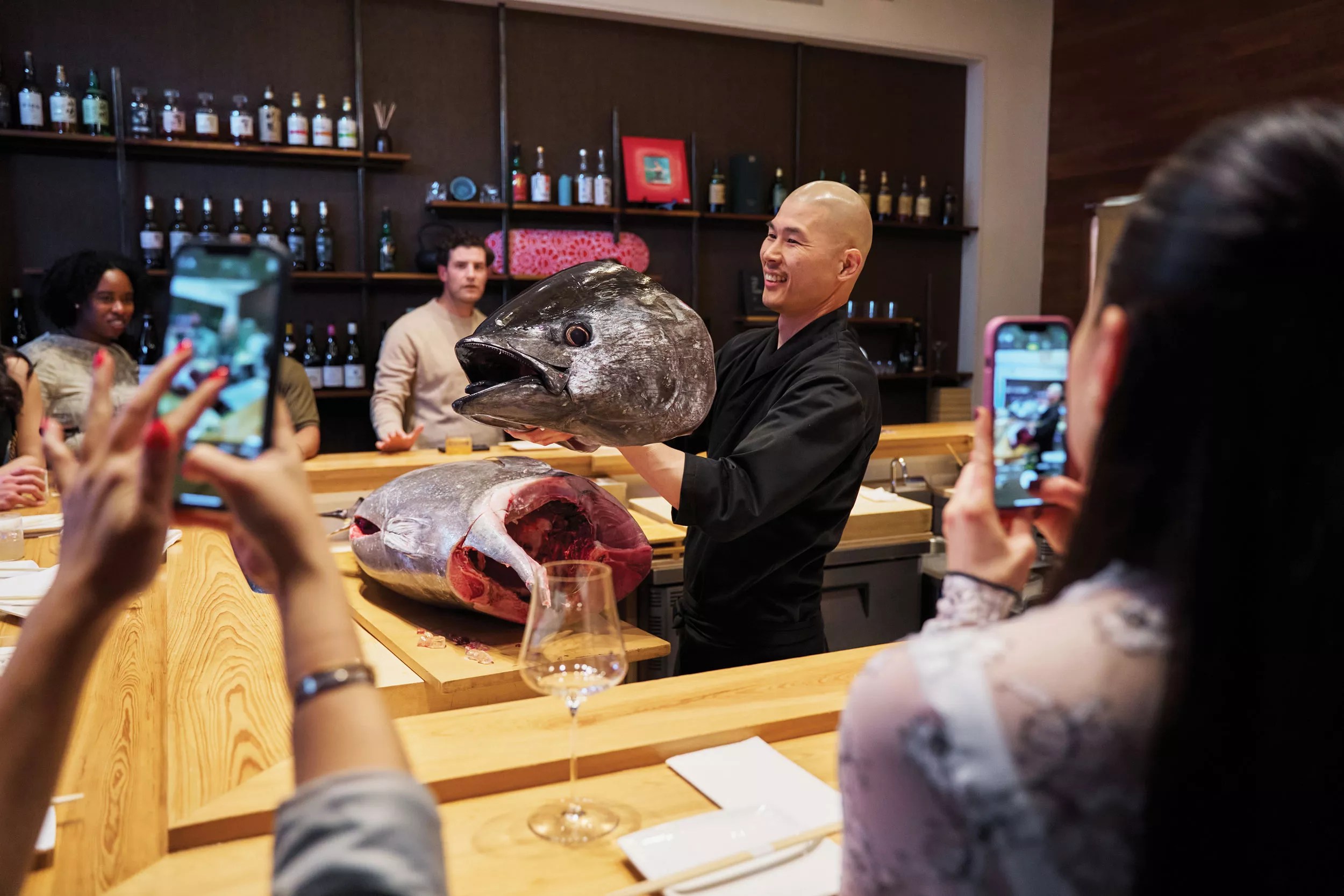
Christopher Durbin

Audio By Carbonatix
As you slip a carefully sliced portion of o-toro into your mouth, your thoughts probably don’t drift to where this fatty slice of tuna belly came from. Toro represents the luxurious apex for most sushi diners, and it’s understandable if you become lost in its creamy texture and rich umami flavors. But thanks to several restaurants in the Dallas area, tuna lovers are getting an up-close look at where their favorite tuna cuts originate.
It’s hard to fathom just how far a Pacific bluefin tuna travels over its lifetime, or the odds a tuna overcomes to reach adulthood. The majority of Pacific bluefin are born during spawning season in the western Pacific Ocean, in an area that stretches 1,300 miles from the Philippine Sea to the Sea of Japan. A female tuna may lay as many as 25 million eggs, of which just one or two may reach maturity.
Marine biologists now believe that by the age of 1, most juvenile Pacific bluefin that survive to that point leave those spawning grounds to begin a 5,000-mile trek across the Pacific Ocean toward the North American coast. Off the shores of California and Mexico, schools of tuna spend several years patrolling the waters in search of smaller schools of fish and squid that make up their diet while dodging larger predators such as sharks and orcas.
By the time a Pacific bluefin reaches maturity at around 5 years of age, it has grown from a 1-millimeter egg to almost 5 feet long and weighs 130 pounds or more. Its sleek body makes it an agile predator, and the tuna’s ability to maintain its body temperature higher than the surrounding water makes it ideally suited to navigate the cold waters of the northern Pacific. Once mature, the bluefin will start a return 5,000-mile trek over the course of two months to the ocean waters near Japan to breed and start the cycle anew.
This year, make your gift count –
Invest in local news that matters.
Our work is funded by readers like you who make voluntary gifts because they value our work and want to see it continue. Make a contribution today to help us reach our $30,000 goal!
100,000 Miles In the Sea
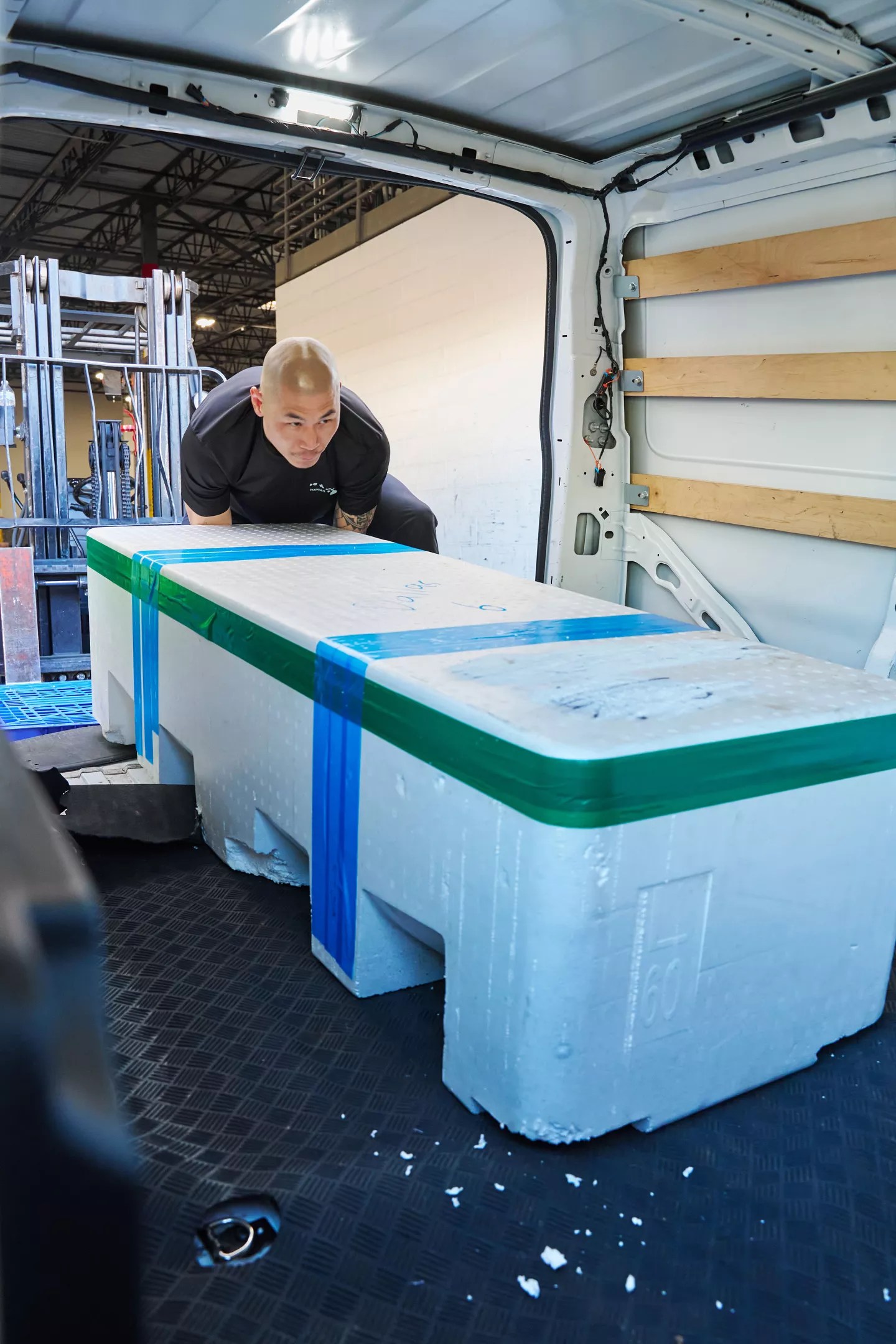
The tuna’s cold case is loaded into the U-haul.
Christopher Durbin
For many sushi restaurants in Dallas, getting fish flown in from Japan is a matter of course. At Namo in Dallas, executive chef Kazuhito “Kaz” Mabuchi and his team make weekly visits to DFW Airport to collect cuts of fish flown in straight from the Japanese market. Mabuchi relies on relationships built with suppliers that allow him to source the highest quality fish for Namo’s sashimi and nigiri, with a lineup that varies with the season.
On a handful of occasions a year, Namo will bring in a nearly whole Pacific bluefin tuna to break it down in the center of the sushi ring. Mabuchi says the event requires some changes in logistics.
“We have to rent a truck from U-Haul,” Mabuchi says. “The fish is wrapped in a silver [thermal] bag, and they pack it in ice inside of a large styrofoam box.”
Before a whole tuna arrives, Mabuchi places a request with his seafood buyer for what he’s looking for. While some Pacific bluefin can be 200 pounds or more, Mabuchi is somewhat limited by the space in the restaurant.
“I usually tell my buyer what size I’m looking for and from what region,” Mabuchi says. “Then they go to the tuna auction on a Monday morning and bid on the fish.”
For Namo’s tuna breakdown dinners, Mabuchi looks for a tuna around 70 kilograms, or 150 pounds. Mabuchi sees this size as a point where the tuna yields great amounts of quality o-toro (fatty tuna belly), chu-toro (medium fatty) and akami (lean), but is still manageable to break down. However, the nature of the auction format means that Mabuchi doesn’t know the exact size (or cost) of the tuna until it arrives. The tuna that Namo receives was likely caught over the weekend off the coast of Japan, sold at auction on Monday, then packed and shipped for its 13-hour flight to Dallas, a journey of over 6,400 miles.
Add in the 10,000 miles the bluefin swam in its round trip from the Sea of Japan to North America, and the years of travel in between (like most fish, bluefin never stop swimming to keep oxygenated water moving across their gills), and it’s safe to assume that a Pacific bluefin might have traveled 100,000 miles or more to make its way to your plate.
Knives Out
Mabuchi arrived around 2 p.m. on a Tuesday in late February to pick up his 130-pound bluefin tuna at a cargo building at DFW Airport for a breakdown later that day. He tries to get there as soon as he gets a notification that shipments arrive.
Mabuchi often Facetimes his contact at the Toyosu Market in Japan for many of his items, but the bluefin tuna auctions are more secretive; no phones or photos.
At the airport cargo facility, the tuna and other seafood for Namo are loaded into the back of the van with a forklift. The other boxes go in first, but the bluefin requires a little more maneuvering; the chef is able to make it fit with a little help from the forklift.
Back at the restaurant, several employees come out to unload the smaller boxes, but then the chef has to drive to the front of the restaurant, avoiding a narrow hallway and stairs, to get the tuna inside.
Just before 6 p.m. that same day, the torpedo-shaped fish – an array of metallic blues, resplendent and strong – is on full display in the dining room. Phones are out and knives are sharp. Its head is large and black with a protruding lower jaw gaping open. Diners spent $400 per person for this feast, which benefited the Children’s Cancer Fund. Within 20 minutes, platters of fresh tuna are passing around the room.
Quite Cheeky
It’s still hard to imagine small delicate slices of sashimi coming from such a large fish until you see a whole bluefin in person.
While Namo only does tuna breakdowns a handful of times each year, in Southlake, Nikko hosts a weekly tuna breakdown that’s become popular. While a reservation at this Japanese restaurant in Southlake’s Town Square is relatively easy to obtain on most days of the week, reservations for the Thursday tuna cutting are booked out for weeks.
At Nikko, the weekly supply of whole tuna is sourced from the Caribbean instead of Japan. Western Atlantic bluefin make similar migrations as their Pacific relatives, journeying from spawning waters in the Gulf of Mexico through the Caribbean and into the Atlantic Ocean, ranging as far north as Newfoundland. Atlantic bluefin are among the largest tuna species and can grow to 13 feet and 2,000 pounds.

Chef Mabuchi prepares to cut the whole fish.
Christopher Durbin
On the Thursday we visited Nikko, the tuna was decidedly smaller. Nikko’s restaurant space comprises a main dining room that borders an L-shaped sushi bar, and Nikko’s staff rolled out a nearly 6-foot-long tuna onto a table in the middle of the dining room. Head sushi chef Dave Ip told us that this evening’s tuna weighed in at 168 pounds. Whole tuna will generally have their organs and gills removed prior to shipping, but Nikko’s example was otherwise intact, save for the tail.
Shortly after 7 p.m., the restaurant was packed, and two chefs began breaking down the tuna as patrons watched. Using a combination of long knives and a saw, they first removed the head from the body of the fish and brought it to Ip’s station at the sushi bar.
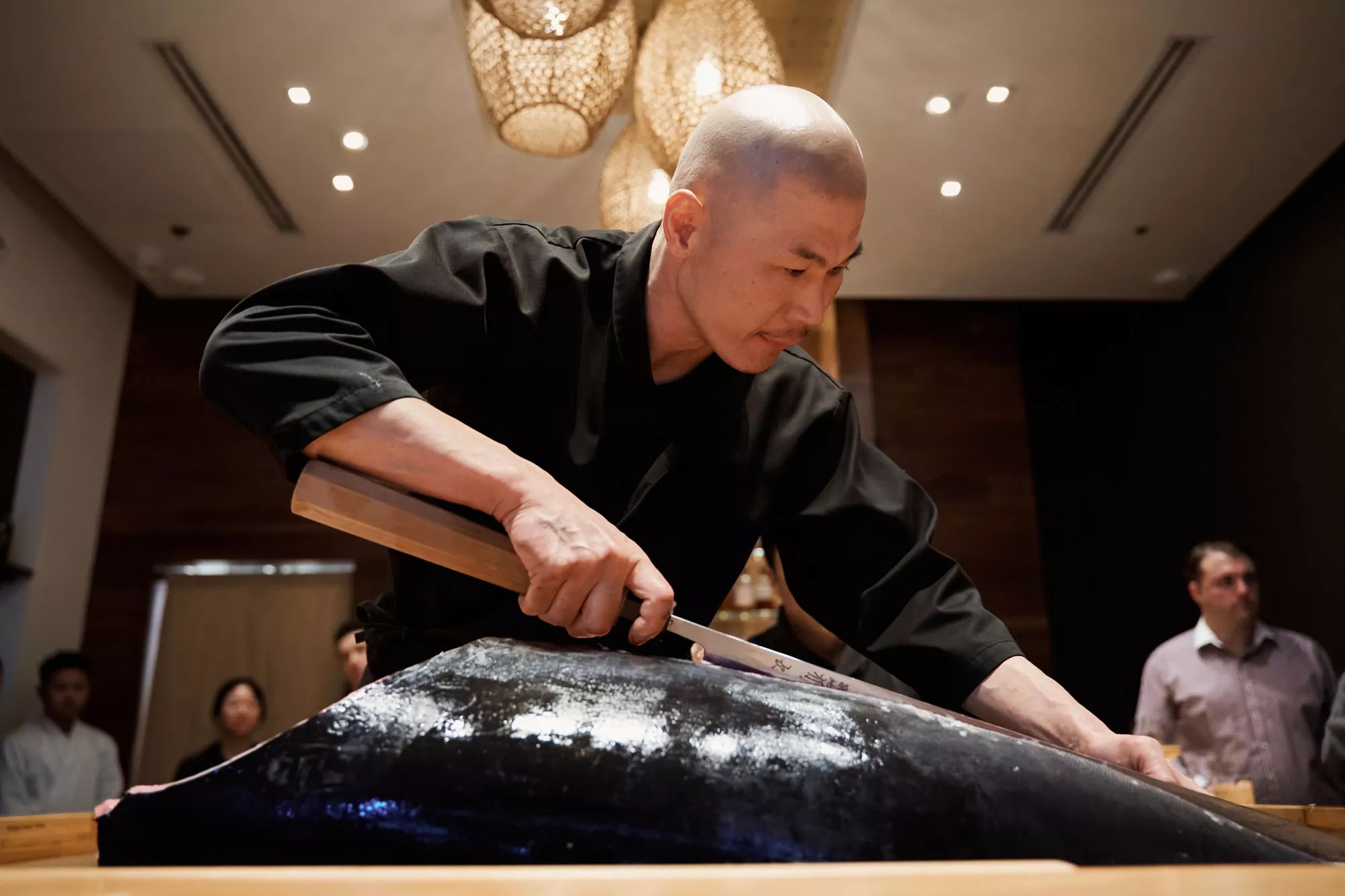
Chef Mabuchi makes an exact quarter cut down the tuna.
Christopher Durbin
Prized cuts like noten (head), hoho-niku (cheek) and kama toro (back cheek) are sourced from the head and neck and are limited in quantity. The two chefs continued their work, separating the remaining fish into five sections: two long pieces of belly loin, two equally lengthy sections of back loin and the spine section itself, where nakaochi (rib meat) will be scraped from the ribs for use in rolls and other dishes.
Nikko’s tuna shows are unique in that you aren’t locked into a fixed-price menu to be part of the show; in fact, you can order off the regular menu and not eat any tuna at all. Once the breakdown of the fish is complete, chef Ip goes to work cutting down the large sections into more manageable sections, and waitstaff distributes a tuna-specific menu with cuts that can be ordered from today’s fish.
Tuna’s Legacy and Comeback
It’s impossible to talk about tuna without talking about the risks the tuna population faces from overfishing. Between bluefin, yellowtail, albacore, big eye and skipjack, tuna fishing accounted for nearly 5.3 million pounds of fish caught in 2021. According to research from the Pew Charitable Trust, the global value of tuna was over $40 billion in 2018, making tuna one of the most valuable fishes on the planet.
Tuna is big business, but overfishing in the 1990s and 2000s, particularly of bluefin varieties, nearly wiped out the population. According to NOAA, overfishing reduced the estimated bluefin biomass to a historic low of 2% of its potential unfished level from 2009 to 2012. As a result of this decline, global action was undertaken to help the tuna population recover, beginning in 2011. A consortium of the seven major tuna fishing countries, along with fishermen and producers, agreed to limit catches and implement controls to reduce the numbers juvenile and large adult bluefin that were taken in. The efforts have paid off; NOAA reported that bluefin stocks had grown to 23.2% of the potential unfished spawning stock in 2022. Bluefin stocks continue to be monitored, but bluefin tuna is no longer considered a threatened species under the U.S. Endangered Species Act.
Demand for tuna remains, but farmed-raised fishing has stepped in to fill the gaps left by lower numbers of wild-caught fish. When farmed-raised bluefin first became available, most chefs and consumers felt the quality was good but not up to the level of wild-caught bluefin. Namo’s Mabuchi credits the improvements over the years to a better understanding of how fish mature and leveraging technology to improve the process.
“Technology and knowledge, not just of tuna, but farm-raised fish in general, has really improved,” Mabuchi says. “The fish are raised in a clean environment, and not trying to overfeed them to make them grow too quickly.”
At Namo, Mabuchi says while the tuna they procure to do a breakdown dinner remain wild-caught, the salmon being served is all farm-raised. Overall, almost half of Namo’s fish comes from some sort of managed population. With variabilities in the ocean waters and unknown pollution levels, Mabuchi points out that wild-caught fish can actually be unsafe to eat.
“The great thing about farm-raised fish is we can control what the fish eat and when they can be harvested,” Mabuchi says. “There are terrible farms out there too, but we’re particular about where we source.”
A Pricey Bite
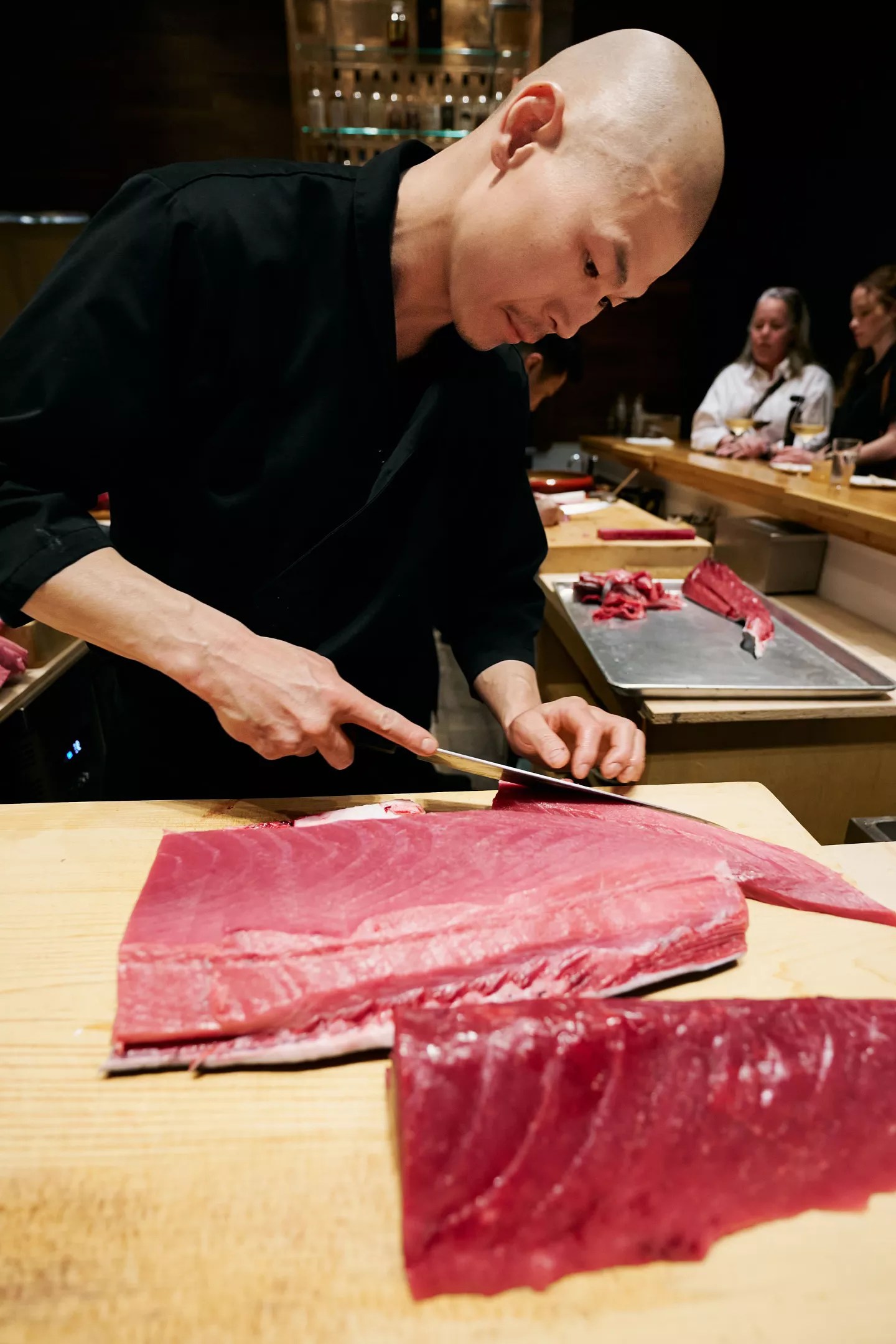
Done with the sectioning, Chef Mabuchi works on the final sushi cuts.
Christopher Durbin
Back at Nikko, chef Ip has finished breaking down the belly into several pound blocks of fish, which have been placed into large bamboo trays on the sushi bar. The orders flowed in for cuts from this evening’s tuna, and we had a front-row seat at the bar to watch as Ip filled the orders with slices of lean and fatty tuna.
There were plenty of orders to fill. A party of three next to us asked Ip how much tuna they might sell from this fish. Ip kind of shrugged and put the number north of $7,000. We ordered two pieces of o-toro nigiri for $11 each, but selections of the head or cheek stretched to $35 or $40 per serving. Still, the number of pieces required to reach seven grand boggles the mind.
When our ticket made its way to the top of Ip’s stack, he grabbed a block of the fattiest tuna belly from one of the bamboo trays, and sliced off two identical rectangles of pink flesh. With one hand, Ip grabbed a small handful of rice from a pot and molded the shape in his palm, placed it on the plate, then deftly created an identical rice base. He carefully laid the o-toro on top, then brushed each with the lightest amount of soy sauce to enhance the flavors, and placed a pea-sized bit of wasabi paste on the plate.
The bites of tuna were exquisite, to be certain. The fish was buttery and silky, and glistened from the delicate ribbons of fat and the touch of soy glaze. There’s something about rich foods like bacon, foie gras or toro that seemingly taste better than any words can describe. Combining fatty tuna with the visuals of seeing the whole bluefin being broken down in front of you creates a food memory that will last a lifetime.
Tuna Breakdowns In North Texas
Namo
3699 McKinney Ave.
Namo arranges a whole tuna dinner several times throughout the year. There’s usually a tuna event for New Year’s Eve, another one in September to coincide with Namo’s anniversary, and one of two other events throughout the year. Prices vary, but the New Year’s Eve event was priced at $350 per person, and included an open bar and champagne toast at midnight.
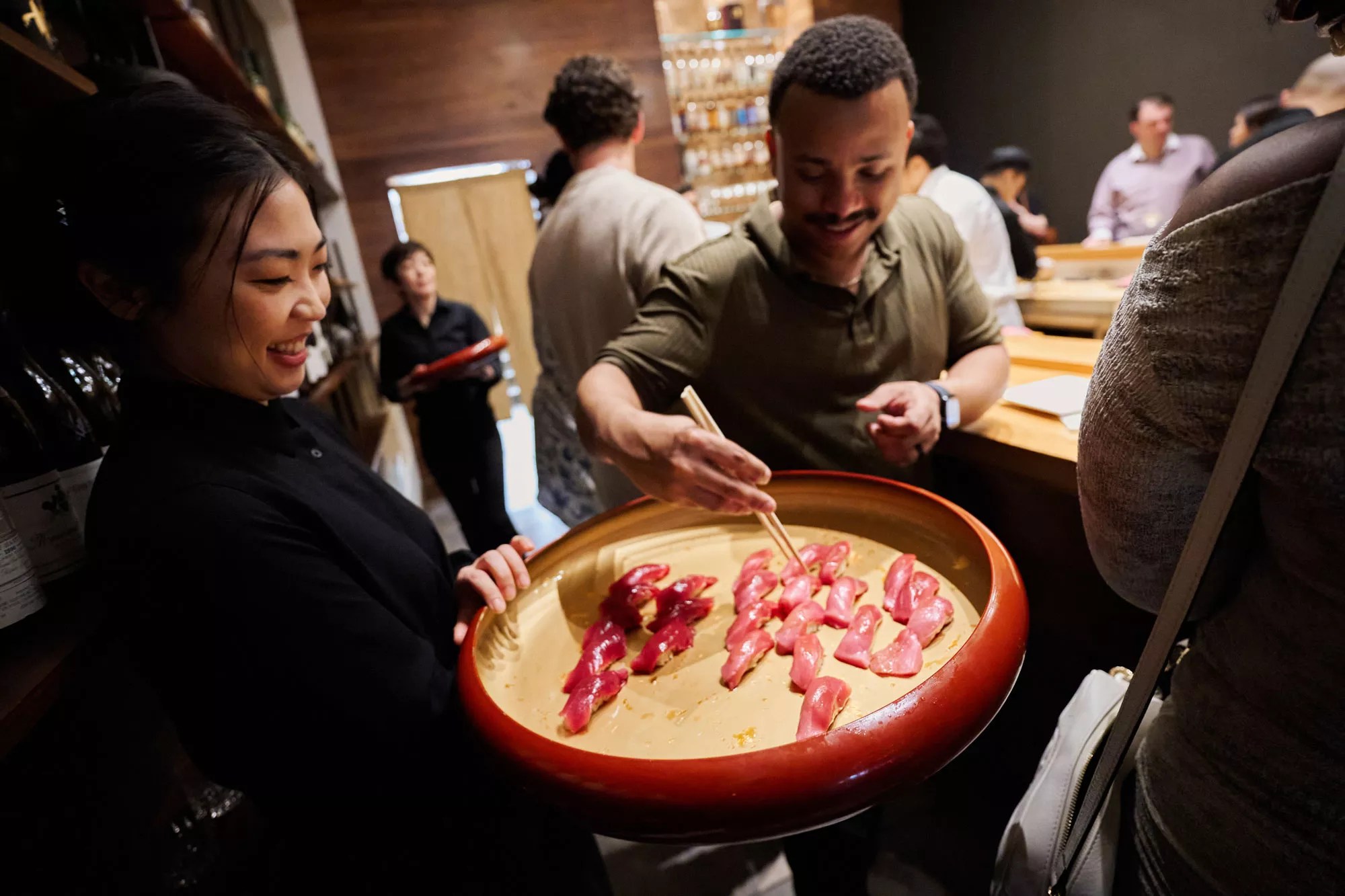
The final and best part — fresh sushi tasting.
Christopher Durbin
Yujo
12835 Preston Road
Yujo has three locations in the area, but only the Dallas location offers The Tuna Show, a 3 to 4-hour tuna-centric omakase event. Yujo offers different levels of omakase experiences that start at $75 for basic tastings, but The Tuna Show usually runs $150 per person for a table seating or $165 to sit up front at the sushi bar. Tickets for the event are usually released two weeks prior and sell out quickly.
Nikko
420 E Southlake Blvd., No. 168, Southlake
Nikko’s tuna cutting show is unique in that it’s offered almost every Thursday, and there’s no fixed-price menu in order to attend. The word is out, however, and reservations are booked weeks in advance. You can order dinner from Nikko’s regular menu of sushi and Japanese dishes, and waitstaff will distribute a tuna-specific menu to order cuts from that day’s whole fish when the breakdown is complete.